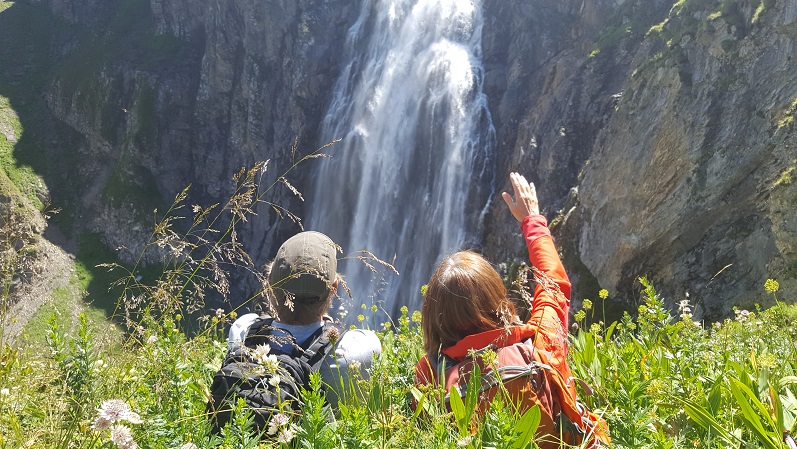If you need another reason to visit Switzerland, how about this: Get a burst of free energy every time you’re near a plunging waterfall or a gushing stream. Fast-moving water is found throughout Switzerland as it tumbles down steep alpine ravines where it swirls special oxygen atoms into the air for your benefit.
Everyone loves being near cascading water, but not everyone knows why. It’s more than the sound of rushing water or the beauty of it bouncing off the rocks. It’s actually influencing your health in a measurably positive way.
Negative Is Positive
It’s the plethora of negative oxygen ions generated by the crashing water that produces the positive effect. Invisible and unnoticeable as they’re tossed into the air, the negative ions are incredibly powerful. Breathe ‘em in and it’s like recharging your personal batteries. You feel immediately refreshed—you may even feel euphoric. The higher the concentration of negative ions, the better you feel.

Positive Is Negative
Now, we don’t need to make a science class out of this, but here’s the basic background. Most offices, stores, factories, transportation, schools and your cell phone bombard you with positive ions all day long. Sounds good, right? Not so. Positively charged oxygen ions are totally negative and are wearing you down. Sadly, those positive ions generate negative results in your brain and body.
Recovery From Urban Life
It’s the negative ions you want. They’re hidden in the spray of fast-moving water. Those plummeting waterfalls are more than breathtaking—they’re health-generating. The negative ions we’re talking about are oxygen atoms that have picked up an extra electron, thus the negative charge. To recover from the toxic environment of urban life, you need a good dose of negative ions to breathe in. According to Pierce J. Howard, PhD, author of The Owners Manual for the Brain, these negative ions generate an increased flow of oxygen to the brain which can make you more alert and energetic while decreasing drowsiness.

Benefits of Waterfalls
Although researchers haven’t decided how much time you need to hang around a waterfall for optimal benefits, they agree that exposure to a good splash of negative ions can positively affect your metabolism, immune system, digestion, blood pressure, sleep, and emotional state. All these advantages are available to you by just sitting still at the base of a waterfall.
Switzerland Is Drenched in Waterfalls
Most of the favorite Alpenwild tours (walking, hiking and trekking) include a walk to a waterfall. It’s part of what you’d expect when you visit a land with snowcapped mountain peaks in every direction. If hiking to a beautiful waterfall (chock-full of those healthy negative ions) sounds appealing to you, then Switzerland is the ideal place to visit.
Top Waterfall Destinations
Here are some of the top waterfalls in Switzerland for producing negative ions. Not every waterfall included in an Alpenwild Hiking Tour is mentioned here, because some are so special they are kept a secret. If you want more information, go the Alpenwild website.
Lauterbrunnen: Staubbach Falls, Mürrenbach Falls, Trümmelbach Falls
Zermatt: Gornerschlucht, Findelnbach Falls
Meiringen: Reichenbach Falls, Aareschlucht, Alpbachfall
Adelboden: Engstligen Falls (Switzerland’s 2nd largest waterfall)
Rosenlaui: Rosenlaui Gorge
Grindelwald: Grindelwald Glacier Gorge
Locarno: Foroglio Falls
Brienz: Giessbach Falls
Griesalp: Pochtenfalls, Wildwasser
Schaffhausen: Rhine Falls (Europe’s largest waterfall)
Kandersteg: Kander Waterfalls, seasonal waterfalls into Öeschinensee
It’s that easy:
- Come to Switzerland
- Relax by a waterfall
- Feel better.

Iffigfall in Lenk Simmental
- The Waterfall Effect: Negative Ions Give Positive Results - September 22, 2019



I don’t understand how oxygen can form positive ions. Normally, when oxygen ionizes, it will have (-2) charge. If an H2O molecule breaks apart, the oxygen atom will strip off an electron from each hydrogen atom. I know that this can happen with electrolysis; how do you know that this is happening with water splashing on rocks. Also, I am not aware of any reaction that would take away a electron from a neutral oxygen atom. Please explain.